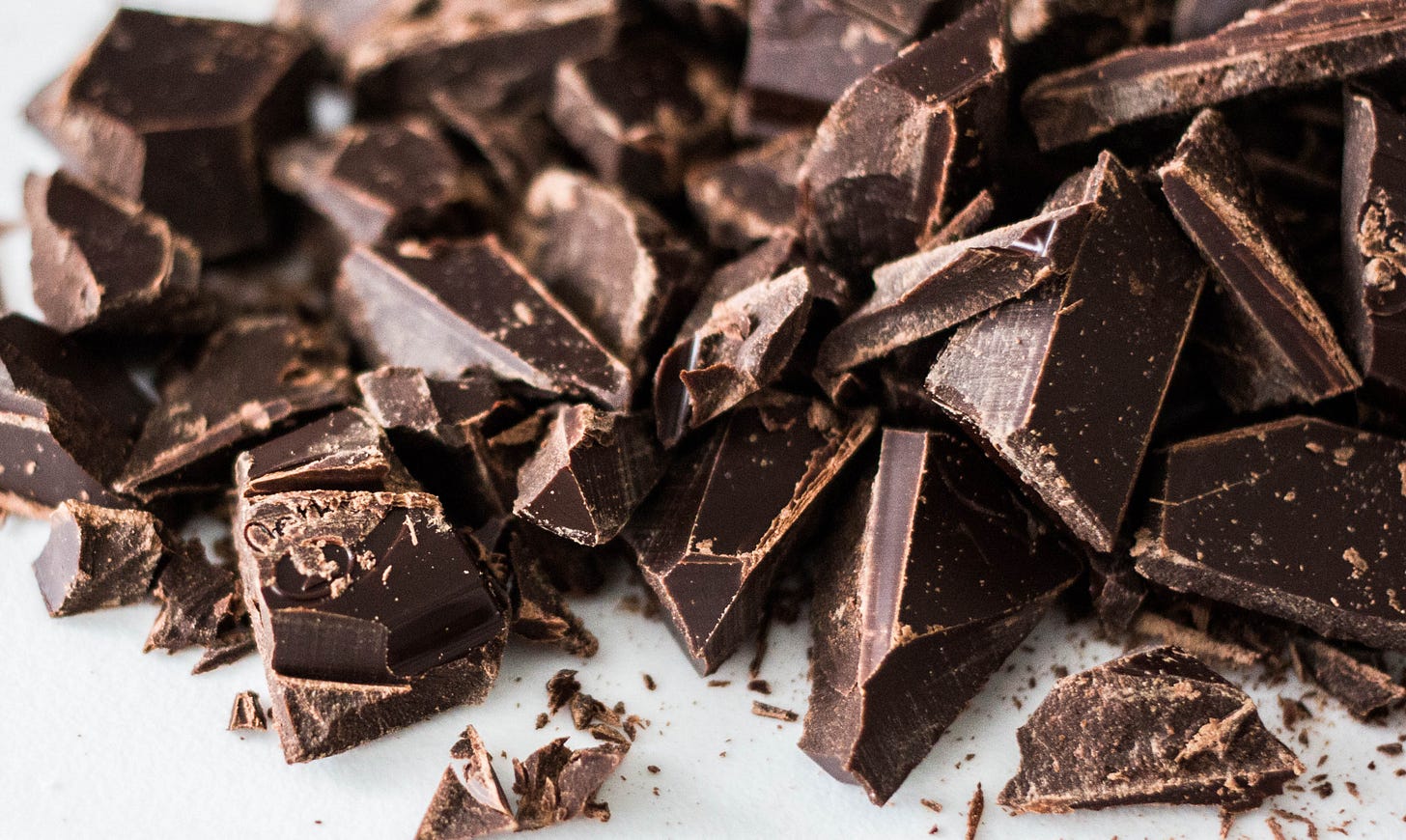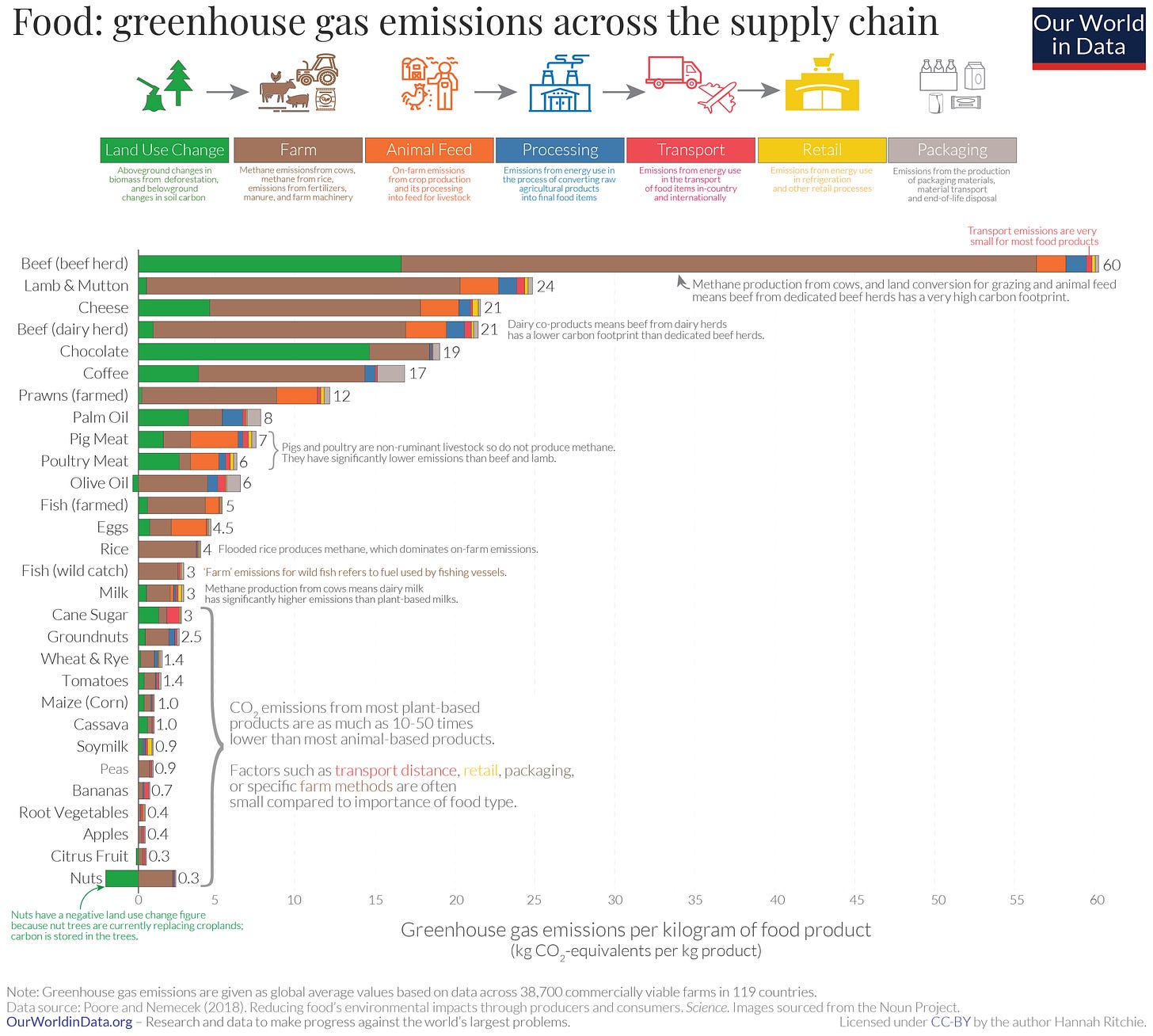
As we round the corner into a particularly chocolate-heavy season, I wanted to take this time to ruin one of the few consolations left in this cruel world. I joke! Mostly. What I really want to do, as always, is examine the hidden and not-so-hidden repercussions of everyday stuff and suggest how we might make better choices to do good and feel good. I’m not here to take away your children’s Halloween candy, though to be clear, I would absolutely steal their KitKats.
Why am I picking on chocolate? Listen, I love chocolate on Cathy-comic levels. It’s my favourite treat! But I also can’t ignore the fact that in terms of the environment and human rights, cocoa can do some serious damage.
Let’s consult my favourite chart to get a quick idea:

Once again, keep in mind this is per kilogram of product, and unless we’re touring the Willy Wonka factory, no one makes a meal of a cool kg of chocolate. But like other fan favourites, cheese and coffee, chocolate is still a heavy hitter. Why is chocolate so costly? First, let’s look at the environmental side of things:
Cacao plantations often lead to deforestation, which is why that land-use segment in the chart is so heavy. Cacao was traditionally a shade-grown crop, but as the world went cuckoo for Cocoa Puffs and other chocolate goods, many crops became full-sun monocultures. Not only does this mean biodiversity loss and fewer carbon-absorbing forests, these crops are inherently unhealthier, so more pesticides and herbicides are applied. Beyond that, 30–40% of the cocoa plants are grown inside protected national parks by farmers desperate for income.
Milk chocolate involves dairy cows (#4 on the chart), complete with their voracious appetites and gassy guts.
Many chocolate bars contain palm oil (#8 on that chart), a tropical crop that’s caused the clearing of vast swaths of vital rainforest in places like Indonesia and Malaysia. Increased rainforest clearing in Indonesia has made the country the world’s fourth-largest source of carbon emissions. In 2015, fires from forest clearing in Indonesia led to an estimated 100,000 deaths from smoke inhalation.
It takes 1,000 litres of water to produce a single chocolate bar.
From a human rights perspective, it’s not good either. Most cacao (the raw beans that are used in chocolate) comes from Ghana and Côte d’Ivoire, where it is not only big business, but the main business. Many cocoa farmers are small-scale producers without bargaining rights when the big chocolate producers come calling, and they’re forced to accept bottom dollar and terrible working conditions. Cocoa prices are half of what they were in the 1980s, and cocoa farmers are earning less than one U.S. dollar a day, putting them in extreme poverty. They’ll only see about 3 to 7% of the total price of a bar. And do you know which kids don’t like chocolate? Probably the ones who have to harvest cacao beans. Though many brands have made pledges to keep kids out of production, child labour actually grew 51% in Côte d’Ivoire between 2009 and 2014. (If you really want to get into cacao production, check out the episode of Netflix’s Rotten about chocolate.)
I know, it’s enough to kill your sugar high. While structural reforms are absolutely needed, are there any ways for us to make better chocolate choices? Absolutely, or I’d never send this email. Plus, the chocolate you get will actually be delicious, unlike those cheap foil-wrapped Easter eggs that I’m pretty sure are 50% dirt. Let’s get into it.
Savour that sweetness.
As always, consuming less is the easiest (if not the most fun) was to lessen your impact. I’m not doctor, but I’m also pretty sure less chocolate is good for you. You don’t have to appreciate each chocolate chip with the wonder of Laura Ingalls getting an orange at Christmas, but let’s remember chocolate is a luxury item. And if you buy better chocolate, chances are you’ll need less of it to be satisfied.
The darker the better.
Many bars tell you how much cocoa they contain — the higher the percentage, the darker the bar. Not only is a darker bar potentially healthier for you, it’s better for farmers, because more cacao is required, thus more money goes to them.
Consider buying fair or direct trade.
There are some legitimate criticisms of fair trade, namely that most of the premium goes to middlemen and that money still isn’t going to the poorest farmers (who can’t afford the certification process). Some studies have found the certification may not in fact do much for agricultural workers. (These arguments are covered in William MacAskill’s Doing Good Better, a book that had a big impact on me.)
That said, with a product like chocolate that has such brutal labour standards, you may, like me, still lean toward some kind of certification. Plus, companies that are fair trade often make other positive social and environmental choices. Canadian companies that are fair-trade certified include Ottawa-based Camino (which also makes cocoa powder, hot chocolate, etc.) and Montreal-based Galerie au Chocolat. Other bigger fair-trade brands include Divine (also cooperatively owned by its farmers, ensuring additional benefits) and AlterEco (which partners with worker co-ops). These are all a little pricier, but Cadbury is another okay option: many of their Dairy Milk bars are fair trade.
But what about the all the little goblins and ghouls who will come knocking soon? (At least if you don’t live in an Ontario hot spot, where trick or treating is currently cancelled.) Dairy Milk makes a fun size, and Mars brand bars (Snickers, Twix, M&Ms, Skittles) are also not the worst — they’ve just announced all their palm oil will be deforestation-free and seem like they’re actually going to monitor it. Ferrero (Ferrero Rocher, Kinder, Nutella) gets top marks for their palm oil sustainability. Despite my love of KitKats, I avoid all Nestlé products because they are evil.
The best option here is direct trade, which means a company works directly with farmers (rather than with a wholesaler), cutting out layers of middlemen, paying farmers more per kilogram than the fair-trade standard and avoiding pricey fair-trade certification. It also means the chocolate company can have a much better sense of what’s going on on the farm. A great example of direct trade? Toronto’s own Chocosol. They work with cacao farmers in Central and South America doing — my favourite — regenerative agriculture, and here in Toronto channel much of the waste product into soil and mulch. Eating their chocolate could help the environment instead of hurting it. Those farmers earn a living wage, with Chocosol paying 30% above fair-trade prices. Their product is also vegan — it won’t be as creamy as some bars but has an amazing depth of flavour, which I can confidently say after eating a full kilogram of it throughout the pandemic. (My fave is the sea salt vanilla bar.)
Find a fuller round-up of fair-trade chocolate bars here. Many are available at health food stores and regular grocers, and Well.ca has quite a collection.
Less packaging = less bad.
Though seasoned FMFP readers know the package has far less environmental impact than the contents, less packaging is still better. Especially when we’re talking about V-Day, Christmas, Mother’s Day, and Easter packaging, where chocolate is not only hugely marked up but manufactured to appear like you’re getting more product when actually you’re just getting hosed.
TL;DR
Chocolate production has heavy environmental consequences, including deforestation, loss of biodiversity, high water use, and high pesticide and herbicide use. It also has a grim human rights record, including child labour.
If you can swing it, buy less chocolate but better chocolate: that might include products that are fair trade or, ideally, direct trade.
Darker chocolate means more income for farmers.
Avoid heavy seasonal packaging: nothing dampens festive feelings like a treat wrapped in a bunch of trash.
Wins of the Week
“All of us are living in a carbon-intensive society. We were born into that, and our goal is to not die in a carbon-intensive society.” — Dr. Leah Stokes (I really like her new podcast with Dr. Katharine Wilkinson, A Matter of Degrees)
Here’s some treat-worthy behaviour from you fine folks this week:
Sarah Joy has committed to making her daughter waste-free lunches for all her days at school. (And she was happy to see that her school encouraged waste-free lunches in their newsletters!) You can find some great tips on how to make a school lunch sans trash over at Sustainable in the Suburbs.
Amy is working on giving up dairy and has found a non-dairy yogurt she likes!
Lindsay canned some green tomato chutney with the green tomatoes left over in her garden and her mom’s. (Some options for your green tomatoes here at You Grow Girl — I use that chutney recipe.)
I salute you all, and I salute your efforts. Things feel heavy and hard right now, but keep carving out those wins where you can. That’s something even better than chocolate.
xo
Jen
Five Minutes for Planet is written by me, Jen Knoch, and edited by the incredible Crissy Calhoun. Opening photo by Charisse Kenion on Unsplash.



